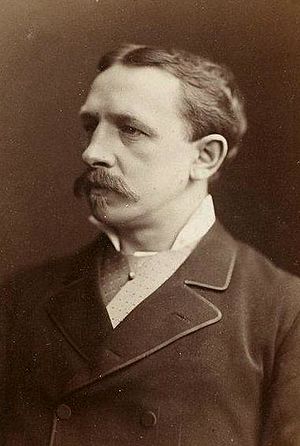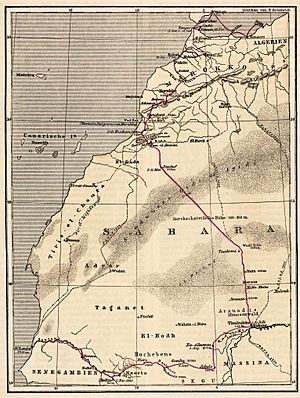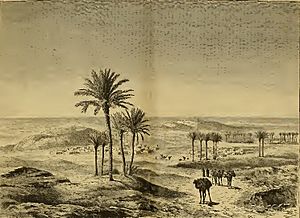Oskar Lenz facts for kids
Oskar Lenz was a German-Austrian scientist who lived from 1848 to 1925. He was a geologist, which means he studied rocks and the Earth's history. He was also a mineralogist, someone who studies minerals. Oskar Lenz is famous for his incredible journeys across Africa. He was one of the first Europeans to visit the legendary city of Timbuktu.
Contents
Early Life and Studies
Oskar Lenz was born in Leipzig, Germany. He loved learning about the Earth. In 1870, he earned his doctorate degree from the University of Leipzig. His studies focused on minerals and geology.
A couple of years later, in 1872, he moved to Vienna, Austria. He started working as a volunteer at the Imperial Geological Reichsanstalt. This was a big organization that studied geology for the government. He became an Austrian citizen that same year.
Adventures in Africa
Oskar Lenz was a brave explorer. He led two very important expeditions across Africa. These journeys helped people learn more about the continent.
First Trip: Across the Sahara Desert
From 1879 to 1880, Oskar Lenz led his first major expedition. This trip took him across the huge Sahara Desert. He started in Morocco and traveled all the way to Senegal.
The main goal of this journey was to study the geology of the region. He wanted to find out if there were valuable iron ore deposits. Iron ore is a rock from which we get iron.
In 1880, Oskar Lenz reached the famous city of Timbuktu. He was with his friend, Cristobal Benítez from Spain. They were only the fourth Europeans known to have visited this historic city. Before them, only Alexander Gordon Laing (in 1826), René Caillié (in 1828), and Heinrich Barth (in 1853) had made it there.
Second Trip: Crossing the Congo
From 1885 to 1887, Oskar Lenz led another big expedition. This was called the Austro-Hungarian Congo Expedition. This time, he crossed the entire African continent. He started in the Congo Basin and traveled eastward to the Indian Ocean.
This journey had several important goals. One was to check the trade situation in the new Congo Free State. Another was to map the area between the Nile River and the Congo River. This area is called the Congo-Nile watershed.
On this trip, he traveled with a cartographer named Oscar Baumann. A cartographer is someone who makes maps. He also had an ornithologist named Friedrich Bohndorff with him. An ornithologist studies birds. Sadly, Oskar Baumann got sick during the trip and could not finish the journey.
Later Career
After his amazing adventures in Africa, Oskar Lenz returned to Europe. In June 1887, he became a professor at the Charles University of Prague. He continued to share his knowledge and experiences with students.
Selected Publications
Oskar Lenz wrote several books and papers about his travels and scientific findings:
- Ueber das Auftreten Jurassischer Gebilde in Böhmen (On the occurrence of Jurassic formations in Bohemia), (1870).
- Skizzen aus Westafrika (Sketches from West Africa), (1878). This book described his first expedition.
- Geologische Karte von West-Afrika (Geological map of West Africa), (1882).
- Wanderungen in Afrika (Travels in Africa), (1895).
- Ophir und die ruinen von Zimbabye in Südostafrika (Ophir and the ruins of Great Zimbabwe in southeastern Africa), (1896).
See also
 In Spanish: Oskar Lenz para niños
In Spanish: Oskar Lenz para niños




